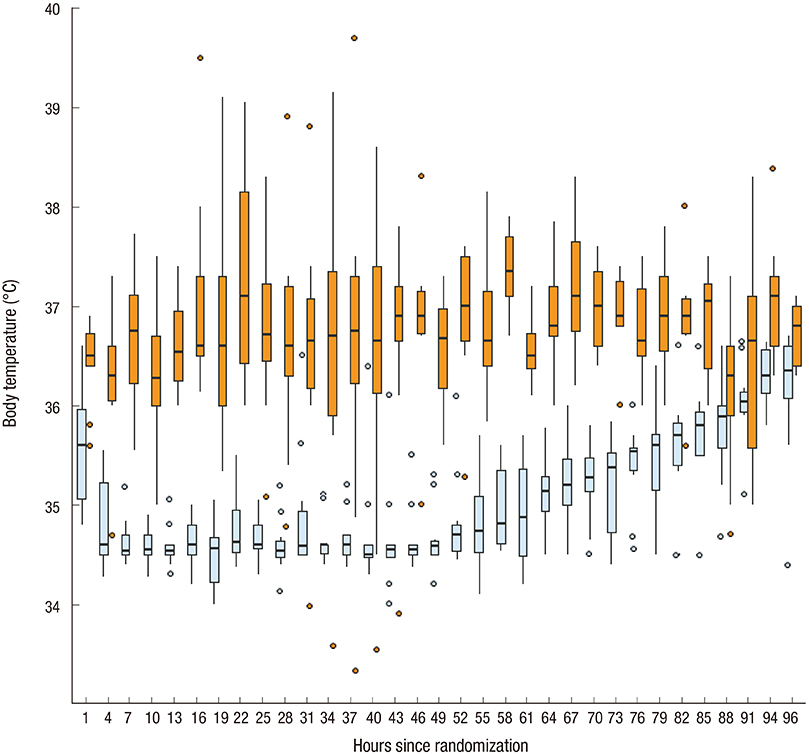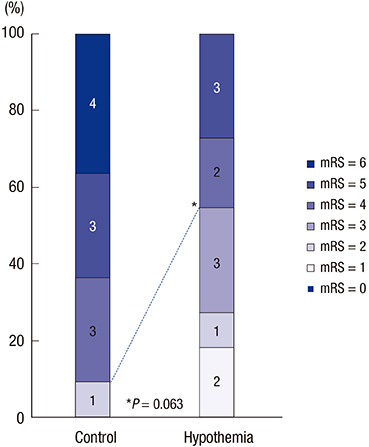J Korean Med Sci.
2017 Aug;32(8):1337-1344. 10.3346/jkms.2017.32.8.1337.
Feasibility and Safety of Mild Therapeutic Hypothermia in Poor-Grade Subarachnoid Hemorrhage: Prospective Pilot Study
- Affiliations
-
- 1Department of Emergency Medicine, Ulsan University Hospital, University of Ulsan College of Medicine, Ulsan, Korea.
- 2Department of Neurosurgery, Ulsan University Hospital, University of Ulsan College of Medicine, Ulsan, Korea. nskwon.sc@gmail.com
- 3Department of Radiology, Ulsan University Hospital, University of Ulsan College of Medicine, Ulsan, Korea.
- KMID: 2439469
- DOI: http://doi.org/10.3346/jkms.2017.32.8.1337
Abstract
- Therapeutic hypothermia (TH) improves the neurological outcome in patients after cardiac arrest and neonatal hypoxic brain injury. We studied the safety and feasibility of mild TH in patients with poor-grade subarachnoid hemorrhage (SAH) after successful treatment. Patients were allocated randomly to either the TH group (34.5°C) or control group after successful clipping or coil embolization. Eleven patients received TH for 48 hours followed by 48 hours of slow rewarming. Vasospasm, delayed cerebral ischemia (DCI), functional outcome, mortality, and safety profiles were compared between groups. We enrolled 22 patients with poor-grade SAH (Hunt & Hess Scale 4, 5 and modified Fisher Scale 3, 4). In the TH group, 10 of 11 (90.9%) patients had a core body temperature of < 36°C for > 95% of the 48-hour treatment period. Fewer patients in the TH than control group (n = 11, each) had symptomatic vasospasms (18.1% vs. 36.4%, respectively) and DCI (36.3% vs. 45.6%, respectively), but these differences were not statistically significant. At 3 months, 54.5% of the TH group had a good-to-moderate functional outcome (0-3 on the modified Rankin Scale [mRS]) compared with 9.0% in the control group (P = 0.089). Mortality at 1 month was 36.3% in the control group compared with 0.0% in the TH group (P = 0.090). Mild TH is feasible and can be safely used in patients with poor-grade SAH. Additionally, it may reduce the risk of vasospasm and DCI, improving the functional outcomes and reducing mortality. A larger randomized controlled trial is warranted.
Keyword
MeSH Terms
Figure
Cited by 2 articles
-
Risk Factors for Intraprocedural Rerupture during Embolization of Ruptured Intracranial Aneurysms
Jun-Min Wang, Qian-Xue Chen
J Korean Med Sci. 2020;35(48):e430. doi: 10.3346/jkms.2020.35.e430.The efficacy of therapeutic hypothermia in patients with poor-grade aneurysmal subarachnoid hemorrhage: a systematic review and meta-analysis
Seungjoo Lee, Moinay Kim, Min-Yong Kwon, Sae Min Kwon, Young San Ko, Yeongu Chung, Wonhyoung Park, Jung Cheol Park, Jae Sung Ahn, Hanwool Jeon, Jihyun Im, Jae Hyun Kim
Acute Crit Care. 2024;39(2):282-293. doi: 10.4266/acc.2024.00612.
Reference
-
1. Park SK, Chun HJ, Kim DW, Im TH, Hong HJ, Yi HJ. Acute Physiology and Chronic Health Evaluation II and Simplified Acute Physiology Score II in predicting hospital mortality of neurosurgical intensive care unit patients. J Korean Med Sci. 2009; 24:420–426.2. Han Z, Liu X, Luo Y, Ji X. Therapeutic hypothermia for stroke: where to go? Exp Neurol. 2015; 272:67–77.3. Schwab S, Georgiadis D, Berrouschot J, Schellinger PD, Graffagnino C, Mayer SA. Feasibility and safety of moderate hypothermia after massive hemispheric infarction. Stroke. 2001; 32:2033–2035.4. Hong JM, Lee JS, Song HJ, Jeong HS, Choi HA, Lee K. Therapeutic hypothermia after recanalization in patients with acute ischemic stroke. Stroke. 2014; 45:134–140.5. Agrawal D. Endovascular treatment for poorest-grade subarachnoid hemorrhage in the acute stage: has the outcome been improved? Neurosurgery. 2003; 52:481.6. Karibe H, Sato K, Shimizu H, Tominaga T, Koshu K, Yoshimoto T. Intraoperative mild hypothermia ameliorates postoperative cerebral blood flow impairment in patients with aneurysmal subarachnoid hemorrhage. Neurosurgery. 2000; 47:594–599.7. Takino M, Okada Y. Hyperthermia following cardiopulmonary resuscitation. Intensive Care Med. 1991; 17:419–420.8. van der Worp HB, Sena ES, Donnan GA, Howells DW, Macleod MR. Hypothermia in animal models of acute ischaemic stroke: a systematic review and meta-analysis. Brain. 2007; 130:3063–3074.9. Kim IS, Kim HD, Kim KU, Shin HC, Choi HJ, Kim KH. The effect of barbiturate in brain protection under mild hypothermia during temporary vessel occlusion in aneurysm surgery. J Korean Neurosurg Soc. 1997; 26:1218–1227.10. Li LR, You C, Chaudhary B. Intraoperative mild hypothermia for postoperative neurological deficits in people with intracranial aneurysm. Cochrane Database Syst Rev. 2016; 3:CD008445.11. Li LR, You C, Chaudhary B. Intraoperative mild hypothermia for postoperative neurological deficits in intracranial aneurysm patients. Cochrane Database Syst Rev. 2012; CD008445.12. Anei R, Sakai H, Iihara K, Nagata I. Effectiveness of brain hypothermia treatment in patients with severe subarachnoid hemorrhage: comparisons at a single facility. Neurol Med Chir (Tokyo). 2010; 50:879–883.13. Feigin VL, Lawes CM, Bennett DA, Barker-Collo SL, Parag V. Worldwide stroke incidence and early case fatality reported in 56 population-based studies: a systematic review. Lancet Neurol. 2009; 8:355–369.14. Kuramatsu JB, Kollmar R, Gerner ST, Madžar D, Pisarčíková A, Staykov D, Kloska SP, Doerfler A, Eyüpoglu IY, Schwab S, et al. Is hypothermia helpful in severe subarachnoid hemorrhage? An exploratory study on macro vascular spasm, delayed cerebral infarction and functional outcome after prolonged hypothermia. Cerebrovasc Dis. 2015; 40:228–235.15. Badjatia N, Strongilis E, Gordon E, Prescutti M, Fernandez L, Fernandez A, Buitrago M, Schmidt JM, Ostapkovich ND, Mayer SA. Metabolic impact of shivering during therapeutic temperature modulation: the Bedside Shivering Assessment Scale. Stroke. 2008; 39:3242–3247.16. Lysakowski C, Walder B, Costanza MC, Tramèr MR. Transcranial Doppler versus angiography in patients with vasospasm due to a ruptured cerebral aneurysm: a systematic review. Stroke. 2001; 32:2292–2298.17. Claassen J, Bernardini GL, Kreiter K, Bates J, Du YE, Copeland D, Connolly ES, Mayer SA. Effect of cisternal and ventricular blood on risk of delayed cerebral ischemia after subarachnoid hemorrhage: the Fisher scale revisited. Stroke. 2001; 32:2012–2020.18. Centers for Disease Control and Prevention (US). Pneumonia (ventilator-associated [VAP] and non-ventilator-associated pneumonia [PNEU]) event [Internet]. accessed on 20 September 2016. Available at http://www.cdc.gov/nhsn/pdfs/pscmanual/6pscvapcurrent.pdf.19. Claassen J, Carhuapoma JR, Kreiter KT, Du EY, Connolly ES, Mayer SA. Global cerebral edema after subarachnoid hemorrhage: frequency, predictors, and impact on outcome. Stroke. 2002; 33:1225–1232.20. Connolly ES Jr, Rabinstein AA, Carhuapoma JR, Derdeyn CP, Dion J, Higashida RT, Hoh BL, Kirkness CJ, Naidech AM, Ogilvy CS, et al. Guidelines for the management of aneurysmal subarachnoid hemorrhage: a guideline for healthcare professionals from the American Heart Association/American Stroke Association. Stroke. 2012; 43:1711–1737.21. Seule M, Muroi C, Sikorski C, Hugelshofer M, Winkler K, Keller E. Therapeutic hypothermia reduces middle cerebral artery flow velocity in patients with severe aneurysmal subarachnoid hemorrhage. Neurocrit Care. 2014; 20:255–262.22. Seule MA, Muroi C, Mink S, Yonekawa Y, Keller E. Therapeutic hypothermia in patients with aneurysmal subarachnoid hemorrhage, refractory intracranial hypertension, or cerebral vasospasm. Neurosurgery. 2009; 64:86–92.23. Todd MM, Hindman BJ, Clarke WR, Torner JC; Intraoperative Hypothermia for Aneurysm Surgery Trial (IHAST) Investigators. Mild intraoperative hypothermia during surgery for intracranial aneurysm. N Engl J Med. 2005; 352:135–145.24. Wei S, Sun J, Li J, Wang L, Hall CL, Dix TA, Mohamad O, Wei L, Yu SP. Acute and delayed protective effects of pharmacologically induced hypothermia in an intracerebral hemorrhage stroke model of mice. Neuroscience. 2013; 252:489–500.25. Callaway CW, Donnino MW, Fink EL, Geocadin RG, Golan E, Kern KB, Leary M, Meurer WJ, Peberdy MA, Thompson TM, et al. Part 8: post-cardiac arrest care: 2015 American Heart Association Guidelines update for cardiopulmonary resuscitation and emergency cardiovascular care. Circulation. 2015; 132:S465–S482.26. Kallmünzer B, Kollmar R. Temperature management in stroke - an unsolved, but important topic. Cerebrovasc Dis. 2011; 31:532–543.27. Rittenberger JC, Polderman KH, Smith WS, Weingart SD. Emergency neurological life support: resuscitation following cardiac arrest. Neurocrit Care. 2012; 17:Suppl 1. S21–S28.28. Albrecht RF 2nd, Wass CT, Lanier WL. Occurrence of potentially detrimental temperature alterations in hospitalized patients at risk for brain injury. Mayo Clin Proc. 1998; 73:629–635.29. Schwarz S, Häfner K, Aschoff A, Schwab S. Incidence and prognostic significance of fever following intracerebral hemorrhage. Neurology. 2000; 54:354–361.30. Hajat C, Hajat S, Sharma P. Effects of poststroke pyrexia on stroke outcome: a meta-analysis of studies in patients. Stroke. 2000; 31:410–414.31. Reith J, Jørgensen HS, Pedersen PM, Nakayama H, Raaschou HO, Jeppesen LL, Olsen TS. Body temperature in acute stroke: relation to stroke severity, infarct size, mortality, and outcome. Lancet. 1996; 347:422–425.32. Zeiner A, Holzer M, Sterz F, Schörkhuber W, Eisenburger P, Havel C, Kliegel A, Laggner AN. Hyperthermia after cardiac arrest is associated with an unfavorable neurologic outcome. Arch Intern Med. 2001; 161:2007–2012.33. Sehba FA, Bederson JB. Mechanisms of acute brain injury after subarachnoid hemorrhage. Neurol Res. 2006; 28:381–398.34. MacLellan CL, Clark DL, Silasi G, Colbourne F. Use of prolonged hypothermia to treat ischemic and hemorrhagic stroke. J Neurotrauma. 2009; 26:313–323.35. Wenisch C, Narzt E, Sessler DI, Parschalk B, Lenhardt R, Kurz A, Graninger W. Mild intraoperative hypothermia reduces production of reactive oxygen intermediates by polymorphonuclear leukocytes. Anesth Analg. 1996; 82:810–816.36. Choi HA, Badjatia N, Mayer SA. Hypothermia for acute brain injury--mechanisms and practical aspects. Nat Rev Neurol. 2012; 8:214–222.37. Gasser S, Khan N, Yonekawa Y, Imhof HG, Keller E. Long-term hypothermia in patients with severe brain edema after poor-grade subarachnoid hemorrhage: feasibility and intensive care complications. J Neurosurg Anesthesiol. 2003; 15:240–248.38. Foroohar M, Macdonald RL, Roth S, Stoodley M, Weir B. Intraoperative variables and early outcome after aneurysm surgery. Surg Neurol. 2000; 54:304–315.
- Full Text Links
- Actions
-
Cited
- CITED
-
- Close
- Share
- Similar articles
-
- Hemodynamics of Poor-grade Subarachnoid Hemorrhage
- The Therapeutic Effect of Nizofenone in the Acute Stage Following Subarachnoid Hemorrhage
- Management Outcome of Poor Grade Patients with Aneurysmal Subarachnoid Hemorrhage
- Management of The Poor Grade Aneurysm Patient
- Mild resuscitative hypothermia in comatose patients of out-of-hospital cardiac arrest: A preliminary clinical feasibility trial



